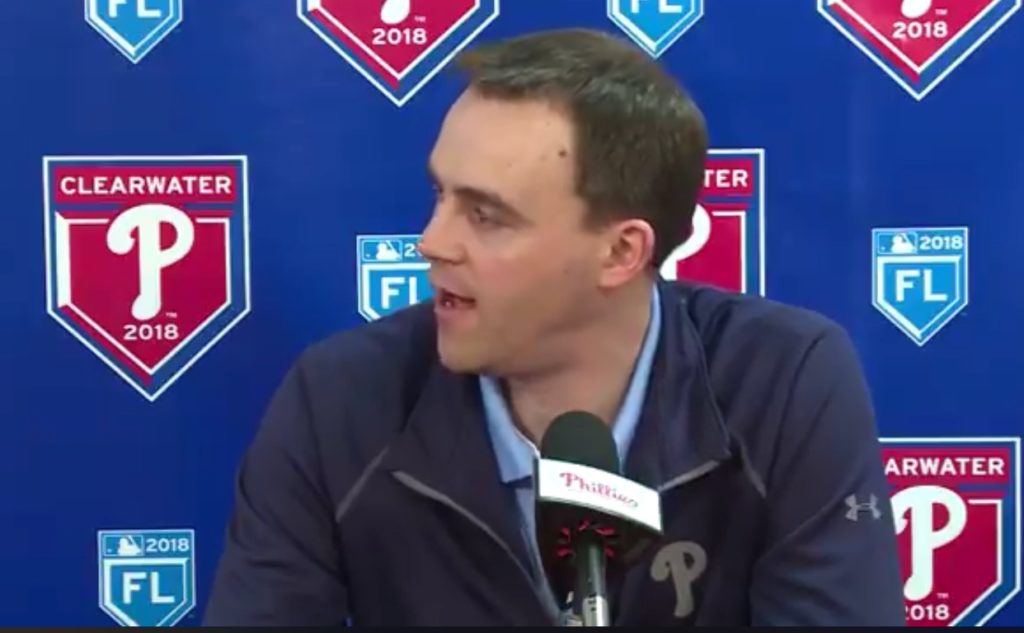Ad Disclosure
Is Matt Klentak Calculating? Or Just Creatively Inept?
By Bob Wankel
Published:

With spring workouts officially underway in Clearwater and the Phillies’ roster an imperfect mesh of presumed youthful talent, question marks, and weaknesses, now is a good time to take a deeper look at its architect, general manager Matt Klentak.
There are varying assessments on his performance to this point. An optimist views Klentak as a patient and calculated man, one who has a firm grasp of the market and a shrewd plan that will maximize the return of his investments whenever he finally strikes. A pessimist wonders if he’s unassertive to a fault and creatively inept. They will say that he’s demonstrated an inability to trade expendable but valuable assets, while also failing to add a starting pitcher to a team that could be a fringe playoff contender in what is–outside of Washington–a weak division.
So who is right? I don’t think it’s fair to answer that question until the end of next offseason, when Klentak has long been expected to finally make good use of the vast financial resources at his disposal. Still, it’s a question worth looking at because its answer will ultimately govern the organization’s ability to run an autumn parade up or down Broad Street in the not too distant future.
Questioning Klentak’s chops is at least worth preliminary examination after the Phillies failed to move what many believed was a valuable and cost-effective commodity in César Hernandez. With second baseman Scott Kingery winning the Paul Owens Award as the Phillies’ best minor league position player after posting a .304/.359/530 slash line in 132 combined games at Reading and Lehigh Valley a season ago, the presumption among fans and league insiders was that a winter promotion would follow and the team would flip Hernandez to fill one of its more pressing needs. After all, the 27-year-old, who is under team control through the 2020 season, hit 294/.372/.406 over the past two years and is set to earn a relatively modest $5.1 million in 2018. He figured to be an attractive option, particularly in a dry market filled with teams reluctant to shell out big dollars to mid-level free agents.
That, of course, didn’t happen, and barring an unexpected development, Hernandez will be the team’s Opening Day second baseman in Atlanta on March 29. To be fair, we’re not privy to what Klentak was offered in exchange for Hernandez, and his trade demands should have been/continue to be substantial. Additionally, the Phillies were not in a spot where they had to make a move, even if it was seemingly the logical thing to do. Again, is Klentak simply showing calculated patience or a lack of resourcefulness and ingenuity in what appeared to be a favorable situation? Those willing to give the young general manager the benefit of the doubt will point to the uncertainty of third baseman Maikel Franco as a reason to hold on to Hernandez. A talented but undisciplined hitter, Franco has been frustrating to watch over the past two seasons as he’s struggled to realize his natural talent. Given the lack of true pressure the team faces to contend in 2018, they can afford to give Franco one more shot to figure it out. It’s nice to hear Klentak actually have some expectations, but this still doesn’t sound like a man who is overly concerned about winning:
Today, Matt Klentak faced the media to discuss the state of the #Phillies and what he's seen so far at camp. pic.twitter.com/sCEdk4WY6Y
— Philadelphia Phillies (@Phillies) February 15, 2018
Anyway, if Franco can’t figure it out, the team has a solid contingency plan in place in which they can move Hernandez or Kingery to third base, while still possessing the flexibility to move Hernandez in the event they want to make a move on Manny Machado ahead of the 2019 season.
The other question worth asking here is–why the hell didn’t the Phillies move an outfielder after signing Carlos Santana and moving Rhys Hoskins to left field? The answer is complicated. We’ve watched both Nick Williams and Aaron Altherr show athleticism and power over a small sample size since arriving in Philadelphia. Do opposing general managers value those flashes, or do they view Altherr as an injury liability and Williams as a streaky hitter with exploitable holes that will eventually hamper him from reaching his ceiling?
Meanwhile, you may not care for Odubel Herrera’s occasional mental blunder, but an ascending 26-year-old former All-Star that is coming off a down year in which he still racked up 59 extra-base hits while on a team-friendly long-term contract makes for an attractive trade chip. It’s hard to imagine there were not reasonable offers for Altherr and Williams, or substantial ones for Herrera—yet each of them are still here. In time, we’ll see if Klentak’s decision to stand pat proves to be prudent or simply a missed opportunity.
To be clear, that Klentak didn’t move any of these players shouldn’t be held against him at this point, because time, expectations, and money are on his side, but his post-Santana winter inertia is something worth keeping an eye on as this process moves forward.
Bob Wankel covers the Phillies for Crossing Broad. He is also the Vice President of Sports Betting Content at SportRadar. On Twitter: @Bob_Wankel E-mail: b.wankel@sportradar.com